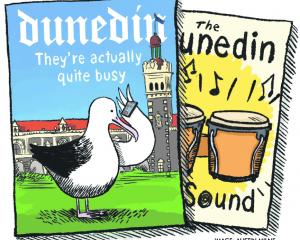
Auckland-based Texus Fibre recently signed an investment and distribution agreement with another Auckland company, Healthy Breath Ltd, which would have the wool-based Helix Filter from Texus used in a new generation of urban masks marketed to Asian consumers.
Specifically-bred sheep, developed by Wanaka man Andy Ramsden, would be used to provide the wool.
Texus Fibre chief executive Nick Davenport said the potential for the business was ''huge'' and Mr Ramsden believed it could be a game-changer in the sheep industry.
''We've created something unique: an end-to-end supply chain which starts by getting the supply genetics right and goes right through to the manufacture of a high-value, scientifically verified product here in New Zealand,'' Mr Davenport said.
World Health Organisation statistics showed poor air quality claimed seven million lives annually and urban air pollution accounted for four million of those fatalities.
Consumers in countries such as India and China bought face masks worth $US2billion each year and sales growth was in double digits every year.
Helix filters harnessed and enhanced wool's functions such as electrostatic performance and toxin removal.
The ''active'' wool fibre structure used the fibre's biological properties to keep the filter drier and performing at optimal levels for longer.
Healthy Breath has taken a stake in Texus Fibre to build on the work developed over five years by Texus and its research partners which include Wool Industry Research Ltd, AgResearch, AgMardt, Callaghan Innovation, NZTE and Nexus Foams Ltd.
Current investors include NZVIF, Global from Day One fund (GD1), Sparkbox Investments, Seraph VC, and K1W1.
Texus Fibre chairman Dr Andrew West said New Zealand wool was going to improve the health of ''millions'' of people.
''At the very heart of this is a New Zealand story, that of high-country sheep producing the world's greatest natural fibre.''
Mr Davenport said the story started about seven years ago. He already had a successful manufacturing company making industrial components from plastic.
He realised that business did not have any IP of its own and started looking for opportunities. Coincidentally, he came across some technology which was being developed in Australia for air filters made from wool.
Thinking it was interesting, he pondered out what else could be made out of wool. Doing some ''desk research'', he found out wool fibre was ''incredibly functional'' and he decided if he could make non-woven wool products, then there would be many applications.
Initially, the technology was still ''rough'' and different performance was achieved every time different wool was bought.
To compete with synthetics, the product had to be consistent and of high quality. If it was not, then it ''wasn't going to fly'' despite its environmental credentials.
He was looking for someone who could supply high quality wool, to a uniform standard, when he got talking to Mr Ramsden.
The breeding programme began five and-a-half years ago, when Mr Ramsden was investigating the idea of creating a new breed to help profitability on better merino country.
It was the third new breed he has developed with special breed objectives and which has been trade-marked.
Choosing to use the Dohne, Cheviot and Finn breeds, some experimentation was required to get the right percentage of breeds to achieve a 24-type micron sheep that scanned predominantly with two lambs.
Mr Ramsden, whose father had a Romney stud in the North Island, said he had a ''life-long'' love of wool.
But wool had been struggling through his lifetime to be truly reflected as a premium product worth growing, from a farmer's point of view, he said.
He was looking to connect his breeding objectives to an end customer.
''In effect, while I was pulling all this together, I was looking for someone like Texus and Texus was looking for someone like me.''
Two years ago, Mr Ramsden joined the Texus board and he was creating the breed for Texus.
He was ''thrilled'' to find someone building ''whole new use'' for wool that was not focused on clothing or carpet.
Human health was a big area for New Zealand's sheep industry to focus on.
Ten years ago, Mr Ramsden helped set up the Headwaters breeding programme, which was now involved in the Omega Lamb Projectand had the goal of producing the world's tastiest and healthiest lamb.
Now with Texus, it was similar but with wool, creating something better for human health.
A new ''space'' for wool was badly needed and the Texus project seemed a perfect fit for Mr Ramsden to become part of.
At 58, he had been ''doing this sort of thing with genetics all my life''. ''This allowed me to bring my background into a very valuable space to help change the future of the sheep industry.''
He believed the Texus-ewe would become the most valuable ewe, for earning ability, in New Zealand.
It would require people to change their genetics and farmers were a very important part of the brand journey. Without them, there was not a product, he said.
Mr Davenport said the first new product in the sector went into the market at the end of last year and the new investment and distribution deal would result in products ''going into more parts of the world in significant volumes.''
It was about improving global health with a natural-based product that had the New Zealand farming industry at its root.
Mr Davenport was ''pretty chuffed'' about the initiative, saying ''we've got to pinch ourselves sometimes that it's happening''.
Now there were people investing large amounts of money into a product that was based around a ''whole massive back story''.
There had to be long-term sustainable returns for farmers to produce the wool required, or they would not be able to do it. Farmers needed to be rewarded, he said.
Mr Davenport was looking forward to a ''huge'' year ahead. Texus had nine staff and was recruiting at the moment and the aim was to reach profitability soon.













